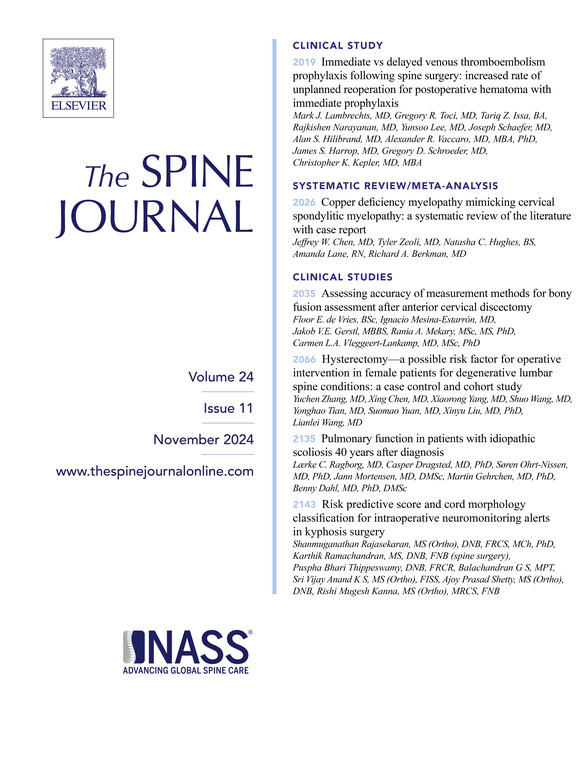接受脊柱手术的患者期望很高,但却没有得到满足。
IF 4.9
1区 医学
Q1 CLINICAL NEUROLOGY
引用次数: 0
摘要
背景情况:目的:通过改良的奥斯韦特里残疾指数(Oswestry Disability Index,ODI)和数字评定量表(Numeric Rating Scale,NRS)评估患者在脊柱手术前的期望值。作者提出的问题是:期望值与实际结果的一致性如何,患者的个人期望值本身能否作为成功的标准?前瞻性单中心研究:研究对象包括计划在阿克苏斯大学医院(AHUS)接受脊柱手术的患者。他们接受了三种手术中的一种:椎管狭窄症减压术、腰椎间盘突出症椎间盘摘除术或椎间盘退行性病变脊柱融合术:结果测量:ODI 和 NRS(腰痛和腿痛)的修正版和标准版:方法:术前,向患者发放改良版 ODI 和 NRS 问卷,要求他们记录手术后预计会出现的最低可接受功能障碍和疼痛。我们将患者的预期与挪威脊柱手术登记处(NORspine)的三个月和十二个月随访数据进行了比较,并使用了ODI、NRS和全球感知效果(GPE)量表。我们采用了简单的描述性统计方法:共有 93 名患者完成了术前问卷调查。结果:共有 93 名患者完成了术前问卷调查,其中 65 人在三个月的随访中做出了答复,53 人在十二个月的随访中做出了答复。术前 ODI 平均值(95%CI)为 38.3(34.2-42.3),术前 NRS 背痛平均值(95%CI)为 6.34(5.81-6.88),腿痛为 6.67(6.08-7.26)。患者预期的平均(95%CI)ODI 为 10.5(7.5-13.5),平均(95%CI)NRS 背痛为 2.5(2.1-3.0),NRS 腿痛为 1.8(1.5-2.2)。12 个月后的实际临床结果是:ODI 平均值(95%CI)为 21.7(17.0-26.5),NRS 背痛为 3.4(2.8-4.1),腿痛为 2.8(2.0-3.5)。只有 12 名(30.8%)患者达到了预期的 ODI,而 26 名(65.0%)患者根据 GPE 将自己归类为明显好转:结论:患者在脊柱手术前似乎有很高的期望值,而这种期望值可能会超过临床结果。只有30.8%的患者达到了他们的ODI预期,但认为获益的比例更高。期望值过高的原因可能是术前信息不足和/或ODI不适合反映期望值。本文章由计算机程序翻译,如有差异,请以英文原文为准。
Expectations in patients undergoing spine surgery are high and unmet
BACKGROUND CONTEXT
Defining success in spine surgery lacks a standardized approach, and all existing concepts are based on registrations after surgery.
PURPOSE
To examine patients’ expectations before spine surgery assessed by a modified Oswestry Disability Index (ODI) and Numeric Rating Scale (NRS). The authors asked: how do the expectations align with actual outcomes and can a patient's individual expectations be used as a success criterion in itself?
STUDY DESIGN /SETTING
Prospective single-center study.
PATIENT SAMPLE
Patients scheduled for spine surgery at Akershus University Hospital (AHUS) were included in the study. They underwent 1 of 3 procedures: decompression for spinal stenosis, disc removal for lumbar disc herniation, or spinal fusion for degenerative disc disease.
OUTCOME MEASURES
Modified and standard version of ODI and NRS (back and leg pain).
METHODS
Preoperatively, the patients were given a modified ODI and NRS questionnaire in which they were asked to register the minimum acceptable functional impairment and pain they anticipated to have postsurgery. The patients’ expectations were compared with 3-and 12-month follow-up data from the Norwegian Registry for Spine Surgery (NORspine) with ODI, NRS and Global Perceived Effect (GPE) scale. We used simple descriptive statistics.
RESULTS
A total of 93 patients completed the preop questionnaire. Of these, 65 responded to the 3-month follow-up and 53 at 12-month follow-up. The mean (95%CI) ODI before surgery was 38.3 (34.2–42.3), the mean (95% CI) preoperative NRS back pain was 6.34 (5.81–6.88), and leg pain was 6.67 (6.08–7.26). The patients expected a mean (95% CI) ODI of 10.5 (7.5–13.5), mean (95%CI) NRS back pain of 2.5 (2.1–3.0), and NRS leg pain of 1.8 (1.5–2.2). The actual clinical outcome after 12 months were a mean (95% CI) ODI of 21.7 (17.0–26.5), NRS back pain of 3.4 (2.8–4.1), and leg pain of 2.8 (2.0–3.5). Only 12 (30.8%) patients achieved their expected ODI, while 26 (65.0%) classified themselves as significantly better according to GPE.
CONCLUSIONS
Patients seem to have high expectations before spine surgery, and the expectations may exceed the clinical outcome. Only 30.8% had their ODI expectations met, but perceived benefit was higher. High expectations may be due to inadequate preoperative information and/or the unsuitability of ODI for capturing expectations.
求助全文
通过发布文献求助,成功后即可免费获取论文全文。
去求助
来源期刊

Spine Journal
医学-临床神经学
CiteScore
8.20
自引率
6.70%
发文量
680
审稿时长
13.1 weeks
期刊介绍:
The Spine Journal, the official journal of the North American Spine Society, is an international and multidisciplinary journal that publishes original, peer-reviewed articles on research and treatment related to the spine and spine care, including basic science and clinical investigations. It is a condition of publication that manuscripts submitted to The Spine Journal have not been published, and will not be simultaneously submitted or published elsewhere. The Spine Journal also publishes major reviews of specific topics by acknowledged authorities, technical notes, teaching editorials, and other special features, Letters to the Editor-in-Chief are encouraged.
 求助内容:
求助内容: 应助结果提醒方式:
应助结果提醒方式:


